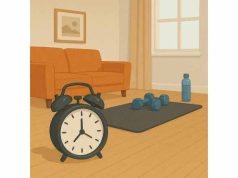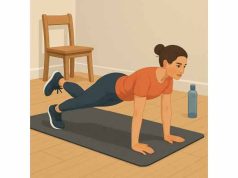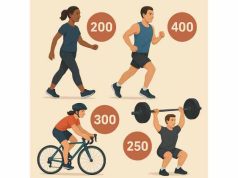
Running is simple to start, easy to scale, and effective for weight loss when you respect progression and recovery. It burns meaningful calories, improves insulin sensitivity, and supports appetite regulation for many people. The challenge is not starting—it is staying consistent without overuse aches. This guide shows you how to build an eight-week beginner plan, set paces without guesswork, and prevent common injuries. You will also learn how to combine running with strength training and daily movement for better, steadier results. For a bigger picture of how cardio, lifting, and step count fit together, see our exercise framework for weight loss.
Table of Contents
- Why running works for fat loss
- Running for weight loss: how to start
- Beginner run-walk plan (8 weeks)
- Build aerobic base (Zone 2)
- Injury prevention and form
- Strength and cross-training
- Progression, plateaus, and troubleshooting
- Frequently Asked Questions
Why running works for fat loss
Running remains a reliable tool for weight loss because it is accessible and metabolically demanding. Per minute, it usually burns more energy than steady cycling or brisk walking at typical beginner intensities. It also stacks well with everyday life: short sessions fit into lunch breaks; longer runs anchor the weekend. With shoes and safe terrain, you can begin within days.
Mechanically, running recruits large lower-body muscle groups—glutes, quadriceps, hamstrings, calves—in a cyclical pattern that elevates heart rate and breathing quickly. The repeated ground contacts provide a bone-building stimulus and can improve tendon capacity when progressed sensibly. That same impact is the reason to respect gradual loading; connective tissues adapt slower than lungs and motivation.
From a weight-management perspective, running helps by increasing total weekly energy expenditure and improving cardiorespiratory fitness. As fitness rises, the same route feels easier and can be done more often, allowing you to accumulate more “easy” minutes—the foundation of sustainable loss. Many runners also find that regular training stabilizes appetite and sleep, both of which support calorie control. The payoff is not a single “fat-burning workout,” but months of repeatable sessions that you can recover from.
To stay consistent, treat intensity as a dial, not a switch. Most of your minutes should be comfortably hard (you can speak in short sentences), with 1–2 short, faster efforts each week to maintain speed. Rest days and gentle cross-training keep you progressing without flare-ups.
If you are new to exercise, have a higher body weight, or are returning after injury, combine walk breaks with short jogs at first. Running does not need to be continuous to be effective; energy burn depends more on total time and effort than whether you walked for a minute.
Finally, remember that running is one piece of a broader plan. Pair it with two short strength sessions and consistent daily movement for better long-term outcomes. For principles on nutrition, recovery, and pacing your efforts within a safe, sustainable plan, skim our safe weight-loss basics and then return here to map your first eight weeks.
Running for weight loss: how to start
Starting well means you will still be running in six months. The goal in Month 1 is not speed; it is learning your easy pace, building a habit, and avoiding overuse. Use the steps below to structure the first ten sessions.
1) Choose frequency before distance
Begin with 3 runs per week on non-consecutive days. This spacing gives your tendons time to adapt. As runs become easier, add a fourth day before lengthening every session.
2) Fit sessions to your current capacity
If you can walk briskly for 30 minutes, you can start a run-walk. Use gentle jogs of 1–2 minutes followed by 1–2 minutes of walking. Keep the total session at 20–30 minutes. The jog should feel slow enough that you could speak a sentence or two without gasping.
3) Use simple effort cues
Skip complex formulas at first. Use Rate of Perceived Exertion (RPE): easy 3–4/10, steady 5–6, hard 7–8, very hard 9–10. Most beginner minutes live at RPE 3–5. If you end a session more tired than planned, reduce the number of jog repeats next time.
4) Pick surfaces and shoes that protect you
Select forgiving surfaces—dirt paths, tracks, or treadmills—while you adapt. Replace worn shoes; a neutral daily trainer with a moderate stack height suits most beginners. Lacing that feels snug at the midfoot and relaxed at the toes reduces rubbing.
5) Warm up and cool down
Start with 5–7 minutes of brisk walking and light drills (e.g., ankle circles, leg swings). Finish with 3–5 minutes of easy walking. These small bookends lower the risk of tight calves and cranky shins.
6) Log the basics
Record date, route/time, how you felt (one line), and any aches. Patterns appear quickly and help you adjust before a minor niggle becomes a layoff.
7) Keep non-running activity high
On non-running days, aim for 7,000–10,000 steps from errands and purposeful walks. If you are building a steps habit, see our primer on daily steps for weight loss.
8) Align nutrition with training
Prioritize protein at meals, include fruit or grains before runs if needed, and hydrate well. Extreme deficits backfire by slowing recovery and inviting fatigue.
9) Respect life stress
If sleep drops, soreness lingers, or work spikes, hold volume steady for a week. Consistency is more powerful than a single “perfect” workout.
10) Expect uneven days
Some runs feel clunky. That is normal. Keep the easy days easy and avoid “making up” missed miles by cramming.
You do not need fancy metrics to begin. Show up three times weekly, keep most minutes easy, and nudge the dial gradually. The formal eight-week plan below turns these principles into clear sessions you can repeat.
Beginner run-walk plan (8 weeks)
This plan builds you from short jogs to continuous running while minimizing injury risk. Each week includes three key runs plus optional gentle activity. Swap days to suit your schedule, but avoid back-to-back hard efforts.
General rules
- Warm-up: 5–7 minutes brisk walk + easy drills.
- Easy effort: You can speak in short sentences (RPE 3–5).
- Harder efforts (when included): Controlled, not all-out (RPE 6–7).
- Cool-down: 3–5 minutes easy walk.
- Optional extras: On one non-running day, add 20–30 minutes of cycling or brisk walking.
Week 1
- Run A: 10 × (1:00 jog / 1:00 walk).
- Run B: 8 × (90 s jog / 60 s walk).
- Run C: 20–25 minutes brisk walk, sprinkle in 4 × 30-second gentle jogs.
Week 2
- Run A: 8 × (2:00 jog / 1:00 walk).
- Run B: 20 minutes continuous easy jog-walk: jog until your breath shortens, walk to recover, repeat.
- Run C: 25 minutes brisk walk or light bike.
Week 3
- Run A: 6 × (3:00 jog / 1:00 walk).
- Run B: 20 minutes easy continuous jog if comfortable; otherwise repeat Run A.
- Run C: 30 minutes brisk walk + 5 × 20-second strides (fast but relaxed, full recovery).
Week 4
- Run A: 5 × (4:00 jog / 1:00 walk).
- Run B: 22–25 minutes easy continuous jog-walk (walk as needed).
- Run C: 25–30 minutes cross-training or recovery walk.
Week 5
- Run A: 4 × (5:00 jog / 1:00 walk).
- Run B: 25 minutes easy continuous jog.
- Run C: 30 minutes jog-walk at easy effort.
Week 6
- Run A: 3 × (8:00 jog / 90 s walk).
- Run B: 25–28 minutes easy continuous jog.
- Run C: 30–35 minutes jog-walk, finish with 4 × 15-second relaxed strides.
Week 7
- Run A: 2 × (10:00 jog / 2:00 walk).
- Run B: 30 minutes easy continuous jog.
- Run C: 25 minutes jog-walk + optional strides.
Week 8
- Run A: 20 minutes continuous easy jog (negative split the last 5 minutes slightly).
- Run B: 35 minutes easy jog-walk.
- Run C: 30 minutes easy continuous jog.
Optional “quality” once weekly (Weeks 5–8)
Only if you feel fresh and pain-free, replace Run A with:
- 4 × 2:00 steadier pace / 2:00 easy jog (RPE 6–7 for the 2-minute blocks). Keep the rest of the week easy.
Paces without gadgets
- If you cannot hold a sentence, slow down.
- If you feel you could sing, jog a touch faster or shorten walk breaks.
- Keep strides relaxed: tall posture, quick feet, no sprinting.
When to repeat a week
- New aches persist beyond warm-up.
- You finish sessions overly fatigued.
- Life stress peaks. Repeating a week is progress, not a setback.
For help spacing easy days and true rest, see our guidance on rest day planning.
Build aerobic base (Zone 2)
The most potent driver of sustainable weight loss from running is not the occasional hard workout—it is consistent easy volume. Zone 2 (comfortable, conversational effort) builds your engine so you can do more work with less strain, which in turn lets you accumulate weekly minutes without breaking down.
Why Zone 2 matters
- Mitochondrial adaptations: Your muscles become better at using oxygen, so pace improves at the same heart rate.
- Technique under control: Good mechanics are easier to rehearse when breathing is steady.
- Recovery-friendly: You can repeat Zone 2 the next day if needed.
- Appetite stability: Many people find steady efforts less likely to trigger intense hunger than frequent maximal sessions.
How to find it
- Talk test: You can speak in short sentences without gasping.
- RPE: 3–5 out of 10.
- Heart rate (optional): Roughly 60–70% of heart-rate reserve or near the top of your “comfortable” range. Do not obsess over numbers; use them as guardrails.
Session ideas
- Continuous 30: Easy jog for 30 minutes; finish the last 5 slightly faster while staying conversational.
- 3 × 10 minutes / 2 minutes brisk walk: Total 36 minutes including recoveries.
- “Out and back” 35–40 minutes: Turn at 17–20 minutes; aim to return a little quicker without straining.
Weekly structure for base building
- 2–3 Zone 2 runs.
- 0–1 light “quality” set (short pickups or steady blocks).
- Short walks on non-running days to keep steps high.
As your base grows, extend one easy run by 5 minutes each week until it reaches 45–60 minutes, provided recovery stays smooth. Resist the urge to convert every session into a test. Easy minutes done often outcompete heroic efforts done rarely.
Want to dive deeper into effort zones and sample aerobic sessions? See our Zone 2 guide for practical testing and progression.
Injury prevention and form
Most beginner injuries are training-error injuries. The common pattern is enthusiasm rising faster than tissues can adapt. A few simple rules and basic form cues prevent many setbacks.
Progression rules
- The 10–15% rule: Increase total weekly running time by no more than 10–15% week to week.
- Every 3–4 weeks, step down: Reduce volume by ~20–30% for one lighter week.
- Alternate hard and easy: Never stack two demanding days.
Form cues that matter
- Posture: Run tall—ribs stacked over pelvis, eyes forward, slight forward lean from ankles, not waist.
- Cadence: Many beginners benefit from a slightly quicker step rate (e.g., nudging toward 165–175 steps/min) to reduce overstriding and braking.
- Foot strike: Land under a bent knee; avoid reaching far ahead. Midfoot or soft heel strike both work if landing is under the body.
- Arm carriage: Elbows about 90 degrees, hands relaxed at ribcage height; think “pocket to cheek.”
Warm-up sequence (5–7 minutes)
- Brisk walk.
- Leg swings (front-to-back, side-to-side).
- Ankle circles and calf raises.
- Two 20-second easy jogs.
Common hotspots and fixes
- Shin splints: Progress volume slowly, prefer softer surfaces, include calf raises and toe raises 2–3×/week.
- Knee ache (runner’s knee): Shorten stride, increase cadence slightly, strengthen hips (glute bridges, side-lying leg raises).
- Achilles tightness: Gentle calf strengthening and controlled eccentric lowers; avoid sudden hill sprints.
- Low back tightness: Maintain tall posture; include hip flexor mobility and basic core bracing.
Recovery basics
- Sleep 7–8 hours when training regularly.
- Distribute protein across meals.
- Hydrate and include sodium if you sweat heavily or run in heat.
- If pain is sharp, local, or worsening, stop and consult a clinician.
For a simple pre-run flow and post-run care, see our warm-up and mobility guide.
Strength and cross-training
Strength training preserves muscle during weight loss, fortifies tissues against running’s repetitive loads, and often improves running economy. Two short sessions each week are enough for beginners.
Priorities
- Lower body strength: Squats, split squats, hip hinges, step-ups.
- Hip stability: Glute bridges, side-steps with a band, single-leg balance work.
- Core bracing: Dead bugs, side planks, suitcase carries.
- Upper body support: Rows and presses for posture and arm drive.
Sample 30–35 minute session (2–3 rounds)
- Goblet squat 8–10
- One-arm dumbbell row 8–12/side
- Romanian deadlift 8–10
- Push-ups 6–10 (elevate hands as needed)
- Split squat 8/side
- Side plank 20–30 seconds/side
Rest 45–75 seconds between moves. Choose loads that leave 1–2 reps in reserve. On running days, lift after an easy run or place strength on a separate day.
Cross-training choices
- Cycling or rowing: Aerobic work without impact; keep most of it easy.
- Elliptical: Similar motion to running with lower joint stress.
- Hiking or brisk walking: Adds volume, builds foot toughness.
How it all fits
- Mon: Easy run + core
- Wed: Strength session + optional short walk
- Fri: Run-walk or easy continuous run
- Sat/Sun: Longer easy run or cross-training
If time is tight, a compact plan like our beginner strength plan pairs well with three weekly runs.
Progression, plateaus, and troubleshooting
Plateaus often reflect insufficient easy volume, too many “kind-of-hard” days, or life stress that quietly erodes recovery. Solve problems by changing one variable at a time and watching the response for two weeks.
Simple progression levers
- Extend one easy run: Add 5 minutes weekly up to 45–60 minutes, if you recover well.
- Add gentle pickups: 4–6 × 20 seconds faster within an easy run, full recovery.
- Consolidate quality: One controlled faster session weekly is plenty for beginners.
When weight loss stalls
- Audit non-exercise activity: Steps dip when you add running. Bring them back up with a daily walk.
- Check sleep and hunger: Inconsistent sleep drives cravings and reduces training quality.
- Review portions: Eat enough to fuel training but not so much that you erase the deficit. Use a few consistent meals on run days to simplify decisions.
If paces stagnate
- Hold volume steady for 3–4 weeks while keeping 80–90% of minutes easy; many runners unlock improvements by removing extra fatigue.
- Add light hill strides once weekly to build elastic strength safely.
- Consider cadence tweaks and short technique cues to reduce braking.
Red flags that justify dialing back or seeking care
- Pain that worsens during a run or lingers into daily life.
- Sudden changes in foot strike due to pain compensation.
- Swelling, localized tenderness to the touch, or night pain.
Mindset for the long game
- Treat this as skill practice. Minutes accumulate; mechanics improve; weight trends down.
- Keep “streaks” flexible—missing a day is feedback, not failure.
- Re-test a familiar route or 20-minute easy run monthly to see progress in pace at the same effort.
Small, boring wins—three steady runs, seven nights of decent sleep, two focused lifts—beat sporadic heroics. Adjust, observe, and keep the easy days truly easy.
Frequently Asked Questions
How fast should a beginner run for weight loss?
Aim for a conversational pace where you can speak in short sentences. That effort typically sits at RPE 3–5/10. If breathing is strained, slow down or insert one-minute walks. Consistency at this easy pace drives sustainable calorie burn and allows gradual progression.
Is running every day good for weight loss?
Daily running can help advanced athletes, but beginners do better with three to five days per week. Rest or cross-training days limit overuse injuries and maintain training quality. As fitness and tissue tolerance improve, you can add a short fourth or fifth easy run.
How many calories does running burn?
Calories burned vary by body size, pace, and terrain. As a rough range, many adults expend about 60–100 calories per mile, or 375–620 per hour at easy paces. Treat these numbers as estimates; track time, effort, and trends rather than chasing exact counts.
Should I run before or after lifting to lose weight?
If running quality is your priority, run before lifting on the same day. If strength is the focus, lift first and run easy later or on a separate day. Keep at least six hours between hard sessions when possible to protect performance and recovery.
How do I avoid shin splints when starting to run?
Increase volume gradually, favor softer surfaces, and keep most minutes easy. Strengthen calves and anterior shins with raises and controlled lowers 2–3 times weekly. Replace worn shoes and avoid sudden jumps in hills or speed until your tissues adapt.
Can I lose weight with run-walk sessions instead of continuous runs?
Yes. Run-walk sessions are an excellent way to build capacity while managing impact. Total time and consistent effort matter more than continuous running at first. Many beginners progress to longer runs by steadily reducing walk breaks over eight to twelve weeks.
References
- Aerobic Exercise and Weight Loss in Adults: A Systematic Review and Dose-Response Meta-Analysis — 2024 (Systematic Review)
- Effect of High-Intensity Interval Training vs. Moderate-Intensity Continuous Training on Fat Loss and Cardiorespiratory Fitness in the Young and Middle-Aged a Systematic Review and Meta-Analysis — 2023 (Systematic Review/Meta-analysis)
- Effect of Strength Training Programs in Middle- and Long-Distance Runners’ Economy at Different Running Speeds: A Systematic Review with Meta-analysis — 2024 (Systematic Review/Meta-analysis)
- What is the Effect of Changing Running Step Rate on Injury, Performance and Biomechanics? A Systematic Review and Meta-analysis — 2022 (Systematic Review/Meta-analysis)
- The Effects of Exercise Training on Mitochondrial Function in Cardiovascular Diseases: A Systematic Review and Meta-Analysis — 2022 (Systematic Review/Meta-analysis)
Disclaimer
This content is educational and does not replace personalized medical advice. Consult a qualified healthcare professional before beginning a new exercise or nutrition plan, especially if you have cardiovascular, metabolic, or orthopedic conditions, are pregnant, or are recovering from injury.
If you found this guide useful, please share it with a friend or teammate. You are welcome to follow us on Facebook or X for practical training templates and updates grounded in evidence.










